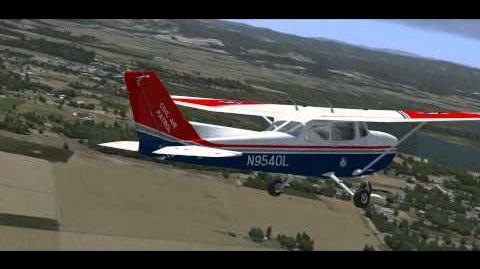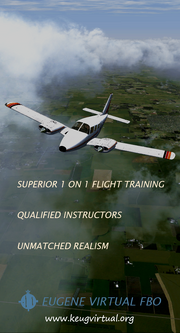Although you can group the Eugene Virtual FBO under "VA's", it really is not a VA at all. It has no scheduled routes, only flies out of a single airport, and its largest

The 2013 logo of the Eugene Virtual FBO.
aircraft can only hold 25 people. That's because it is its own kind of virtual organization. Although the people of Eugene Virtual were not the first to imagine the idea of a FBO-based group, they very well may have perfected the idea. By having a single fixed base of operations, the FBO can focus on its main objectives: flight training, air charter, and general aviation events.
Background[]
The FBO was founded in the early months of 2012 as a project between two studen

KEUG Virtual - Its Time to Fly - Official Promo
The 2012 official FBO promo featuring the "It's Time to Fly" slogan.
t pilots. As the organization grew so did the scope of the operations conducted at the FBO. The first major addition the the operations was the virtual civil air patrol squadron which conducts search and rescue operations using general aviation aircraft such as the Cessna 172 and Cessna 182. Soon after several other additions were made including the release of the 2nd version of the website. After that the "It's Time to Fly" slogan was coined and the official promotional video was made. From there on gradual improvements were made to the organization, until early 2013, when the FBO moved to a community teamspeak server, greatly impacting the flow and pace of operations. Still, the FBO steadily grew in size. In early August version 3.0 of the website was released (http://www.keugvirtual.org).
Operations[]
The FBO is based out of Malhon Sweet (ICAO: KEUG), Oregon. The nearby seplane base OR69 is also used to supplement seaplane operations. KEUG has 2 runways, one of rougly 8,000ft in legnth, and one of 6,000ft. This allows the fleet to operate easily out of the airport.
The FBO's training fleet consists of the following:
| Type | Model | Tail Number | Year Built |
| Cessna | 172N | N2095K | 1981 |
|
Cessna |
172SP | N0481T | 1992 |
| Piper | PA 34 Seneca | N232KA | 1974 |
| Piper | PA 28 Arrow | NW0811 | 1979 |
|
Cessna |
208B | N0WT43 | 2009 |
| Cessna | 206 II | N0WK49 | 1987 |
|
Cessna |
Citation 10 | N283CF | 1998 |
|
Douglas |
DC3 | N0483LP | 1948 |
| Embraer | Phenom 100 | N458PL | 1989 |
|
Dassault |
Falcon 50 | N50XY | 1982 |
|
Glider |
ASH25 | NB670L | 1993 |
|
Beechracft |
King Air C90 | N870SC | 1978 |
|
Bell |
206 Jetranger | N087NP | 1987 |
| Bombardier | Learjet 45 | N08WE | 2001 |
| Robinson | R44 | N603DK | 2003 |
|
Piper |
J3 Cub | N068952 | 1983 |
|
Cessna |
172N Floats | NS48C | 1993 |
| Cessna | 172SP | N048CP | 1991 |
| Cessna | 172SP | N1167CP | 1987 |
| Cessna | 182T G1000 | N451CP | 2005 |
| Cessna | 182Q | N321CP | 1998 |
| Gippsland | GA8 | N078CP | 1996 |
| Robinson | R22 | N732GI | 2001 |
| Beechcraft | D18S | N9109R | 1938 |
| American Champion | 8KCAB | N1098S | 2007 |
| Boeing | 737-600 | N333CC | 2011 |
|
American Champion |
7AC | N125WP | 1965 |
| Beechcraft | V35B | N829K | 1972 |
| Beechcraft | V35B | N295K | 1984 |
Real World Ties[]

The 2013 advertisement poster for the FBO.
Although the FBO does not officially communicate with any real world FBO's based in Eugene, it does have many real world pilots that fly with the organization. When looked at in May 2012, 80% of FBO members had flown an aircraft before, and 50% has a Private Pilot certificate or better. This extremley high real world pilot ratio is further blosterd by the several resident CFI's that are present within the organization. Although home flight simulator use can never make up for real world training, the "help" that the FBO has provided to student pilots with studying for exams, learning about the aircraft, and reviewing procedures is well documented within the organization.